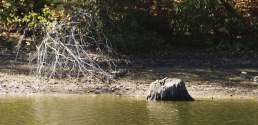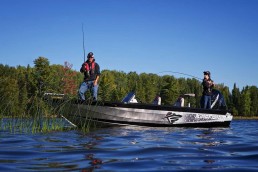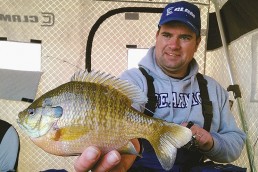Where the Stumps Lie: Find Fish-holding Cover Now
SHARE THIS POST
During my guiding years, I spent my winters looking for backside cover. Actually, I started scouting the winter shallows a couple of years before I started guiding. That taught me so much about the lake and improved my catch so drastically it probably was the main reason I felt confident enough to become a full-time fishing guide.
You can study all the topographical maps you can get your hands on and keep one eye on your depth finder all year, but nothing will teach you more about shallow-water undulations and exactly where the submerged stumps and brush piles lie than seeing it laying bare during low water. Even the best sonar isn’t perfect; it’s easy to miss things. But nothing hides on low water. Dry winters, when lake levels drop below the normal winter pool, are especially educational.
The normal water levels of all major lakes varies a half-dozen feet or so between summer and winter pools, enough to reveal most everything you need to know about the spring migration routes and spawning areas of bass, crappies and bluegills.
Most fishing during spring and early summer takes place in 12 feet of water or less. During the winter, everything that normally lies in 6 feet or less is completely exposed, and much of the significant cover between 6 and 12 feet can be seen peeking just above the surface, or lying just below it.
You can also see the exact path of ditches and creeks winding into the backs of bays. Deeper banks and shallower flats are obvious, and stump fields, brush piles and all manner of “secret” clumps of cover planted by other fishermen (and guides) become visible.
It’s not just revealing in coves. Many of the structural features of main-lake banks become obvious as well—and not just where the cover is located but the angle and slope of the banks, the types of bottoms they contain and the way the points spread their long fingers out into the depths. Many of the main-lake humps, which can be so productive during the summer, are easy to see or easy to locate by trolling over them during the winter when the water not only is lower, but also much clearer.
Are you enjoying this post?
You can be among the first to get the latest info on where to go, what to use and how to use it!
I especially like finding big, isolated stumps on otherwise barren banks or isolated stumps or any kind of structure lying along ditches or creek channels leading into the backs of bays. These are the kinds of places that bruiser bass inhabit, and are the kinds of features no one is likely to find unless they actually see it on low water. In fact, if you’ve never scouted the shallows during winter you’d be amazed by the number of hot spots scattered around if you do.
Don’t make the mistake I did during my first year or two of thinking you can remember them all. Make notes, take pictures and mark the banks somehow because a cove or bank will look much different after the water comes back up, and it’s often hard to regain your bearings. But please don’t hang plastic jugs or soda cans in the trees along the banks or tie a plastic bottle to the cover. This not only is unsightly and littering, but anyone with half a tackle box is going to be wise to this trick. All you need to do is make note of the natural features along a bank, such as a fallen tree, a taller tree or other unusual feature. Be sure you chose something that remains above the surface, even on high water, otherwise a small piece of reflective tape or surveyor’s tape placed discretely will do. Try not to make any marker too obvious.
Most of my winter scouting for spring and early-summer fishing hot spots is done from a boat, but I also like to walk the banks during the winter and do a little “treasure hunting” at the same time. I find all sorts of crankbaits and such that summer fishermen have lost along the banks and left hanging on what was then submerged cover.
On foot is how I most often discover actual spawning areas of bass and bluegills. The bowl-shaped depressions they fan out during normal spring water levels sometimes become silted over by winter, but the footprints of their reproductive efforts remain visible.
It’s a fascinating way to spend a winter day, and what you learn will definitely improve your catch-rate the following spring and early summer.
MWO
SHARE THIS POST
Did you enjoy this post?
You can be among the first to get the latest info on where to go, what to use and how to use it!
Ron Kruger
Ron Kruger has been communicating the outdoor experience for more than four decades. He has worked as a full-time guide for trout on the North Fork, for crappies and bass on Kentucky Lake and for smallmouths on the Current River. He has served as editor of three outdoor magazines, and owns a patent on a fly/lure called the Desperate Diver.



